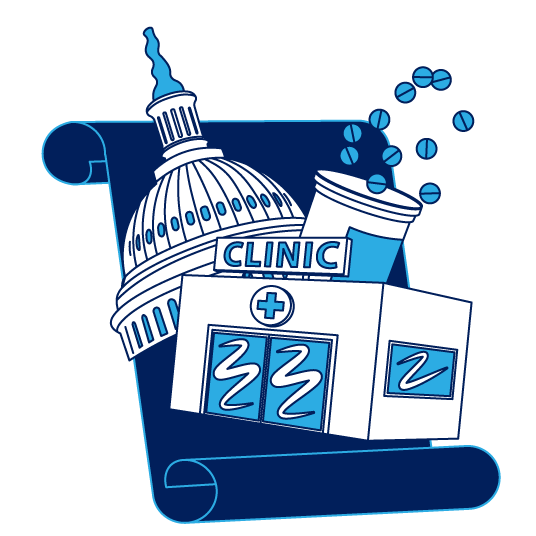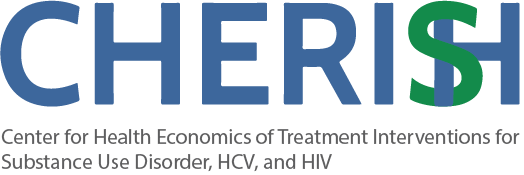
New Rules for Methadone Doses at Home Did Not Increase Overdoses
More Flexible Methadone Take-Home Policy Improved Patient Autonomy
Substance Use Disorder
Blog Post
Produced in conjunction with the Center for Health Economics of Treatment Interventions for Substance Use Disorder, HCV, and HIV
The two main medications that treat opioid use in the United States reduce overdose deaths by 50%. Yet fewer than one in 10 people with opioid use disorder (OUD) can access this kind of medical protocol, according to the Centers for Disease Control and Prevention (CDC).
Fortunately, a new law and a new federal regulation are likely to reduce fatal opioid overdoses—over 80,000 in 2021—by making buprenorphine and methadone treatments more available, say experts at the University of Pennsylvania’s Leonard Davis Institute of Health Economics (LDI) and other colleagues who have analyzed the changes.
“Methadone and buprenorphine are so effective that anything that increases access is a big improvement,” said LDI Senior Fellow Margaret Lowenstein, an Assistant Professor of Medicine at Penn’s Perelman School of Medicine. The Mainstreaming Addiction Treatment Act, passed in December, removes the requirement that caregivers, doctors, physician assistants, nurse practitioners, and others undergo special training to get what’s known as an “X-waiver” to prescribe buprenorphine, which patients pick up at pharmacies. In the same month, the Substance Abuse and Mental Health Services Administration (SAMHSA) proposed rules that make it easier for people with OUD to take home methadone from opioid treatment programs (OTPs), so they don’t have to appear at a clinic almost daily.
Yet as positive as these changes are, they likely do not go far enough to seriously transform the opioid epidemic, say three LDI Fellows and two faculty members of the Penn-affiliated Center for Health Economics of Treatment Interventions for Substance Use Disorder, HCV, and HIV (CHERISH). Below, these experts assess the impact of these new rules and offer ways to further increase treatment coverage of people with OUD.

Opioid treatment programs are the only places that dispense methadone. They were first established in the 1960s and are typically located in lower-income, inner-city neighborhoods. “From the very beginning, methadone was highly regulated, requiring frequent (almost daily) visits by patients and frequent toxicology testing. Methadone is referred to as ‘liquid handcuffs’ because of the restrictive rules and practices. The restrictive regulations reflect stigmatizing and racist notions of people with OUD,” explained Yuhua Bao, Professor of Population Health Sciences at Weill Cornell Medicine in New York.
During the COVID-19 pandemic, many programs allowed some stable patients to get more take-home doses and avoid in-person contact at the clinics, giving them more freedom to get on with their lives. The recent SAMHSA rules about methadone codified the liberalization. “This is an important and positive thing,” said Alexander Walley, Professor of Medicine at Boston University Chobanian and Avedisian School of Medicine and the Grayken Center for Addiction at Boston Medical Center. However, noted Walley, increasing potential access during the pandemic did not expand actual uptake “as much as might have been hoped.” One problem is that “medical providers are conservative about their practices,” Walley said.
What would dramatically increase access to methadone? “Success in other countries in expanding access to methadone treatment has been achieved partly by making methadone available for daily, weekly, or monthly dosing at retail pharmacies, allowing methadone to be prescribed through physicians’ offices (like other medications), including primary care,” said Walley. “This would be the game-changer,” noted LDI Associate Fellow Ashish Thakrar, a fellow in the National Clinician Scholars Program at the Perelman School of Medicine.
Other desirable reforms mentioned by the LDI Fellows and colleagues include the use of mobile OTP vans to dispense methadone, especially in underserved rural areas; dropping the requirement that methadone users undergo counseling; and realigning payments so that OTPs have an incentive to prescribe take-home medication rather than simply getting paid per visit.
Of the two sets of recent legal changes, the Mainstreaming Act “will have a bigger impact,” predicted Thakrar. The removal of the X-waiver requirement is intended to increase the universe of health care professionals who prescribe buprenorphine, which, unlike methadone, is often covered by non-governmental health insurance. Even before the end of the X-waiver, accessing buprenorphine presented fewer challenges to OUD patients. Patients can be treated in a primary care setting rather than a methadone clinic and can obtain their medicine at a pharmacy for one to four weeks.
“Buprenorphine is safer than other opioids that doctors routinely prescribe, but the X-waiver signaled that there is something scary about the drug. Dropping the waiver helps destigmatize buprenorphine,” Lowenstein said.
“[Now] if a provider is approached by a patient who requests buprenorphine, they can prescribe it right away rather than waiting to apply for a waiver,” said LDI Senior Fellow Shoshana V. Aronowitz, an Assistant Professor of Family and Community health at Penn’s School of Nursing.
“[However], existing studies using data from the waiver era show that half of providers with the X-waiver did not prescribe buprenorphine and the other half mostly prescribed well below the limits of concurrent patients,” noted Bao. She added, “The hurdle is greater for providers in a practice that has not yet started treating OUD because the stigma is greater and there is concern that treating OUD patients might drive away non-OUD patients.”
One improvement proposed by both Thakrar and Lowenstein would be to increase the use of telehealth by buprenorphine prescribers. “This would go a long way toward improving access,” Thakrar said.
Thakrar also recommends a more fundamental shift that might increase the use of all forms of medication treatments for opioid disorders: educating medical students and residents about these treatments. “There’s a risk that current providers don’t understand that addiction is treatable,” Thakrar said.
If the Eliminating a Quantifiably Unjust Application of the Law (EQUAL) Act had made it into the 2022 omnibus spending bill, it would have revoked a statute that punishes sale or possession of crack cocaine much more severely than powder cocaine, a sentencing protocol that has resulted in a disproportionate number of people of color landing in prison for long terms. Last December, Attorney General Merrick Garland issued guidance that effectively ended this disparity in sentencing. However, the rule does not apply retroactively to people currently incarcerated, which the EQUAL Act would have done if it had passed. “Any legislation that moves toward less criminalization of drug use would help reduce stigmatization of OUD and improve the availability of effective treatment,” Walley said.
Aronowitz proposes a bigger change: “We really shouldn’t criminalize substance use at all,” she said.



More Flexible Methadone Take-Home Policy Improved Patient Autonomy

Pediatricians’ Suggestions for Health Care Providers, Institutions, and Policymakers

Pain Is Hard to Predict, and a Cheap Disposal Kit Offers a Solution

New Geographic Trends Raise Questions About the Future of Behavioral Health Services

This Model Is Cheaper And Easier To Use Than The ER, LDI Fellow Argues In New Op-Ed